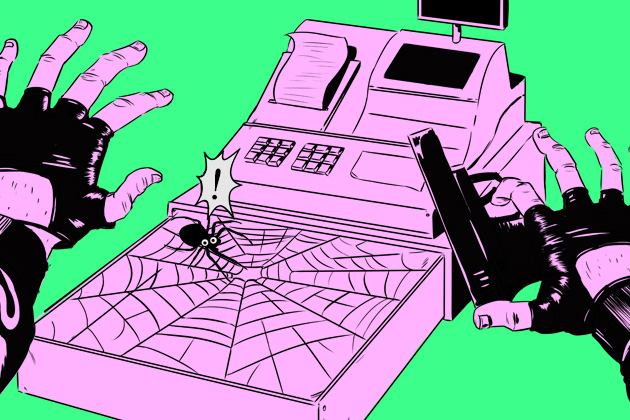Cash, after all, is what burglars and muggers are usually after - that or stuff that can easily be turned into it. Cash is harder to trace than plastic - for law enforcement officials or tax inspectors - and therefore favored by underground entrepreneurs, such as drug dealers and pimps. Junkies who steal to feed their habit need cash because they can't pay for drugs with a credit card. A new working paper makes the case, in the somewhat turgid language of economic research:
"The proposition that flows logically from this model is that cash is a necessary functional component of the etiological cycle that drives many sorts of predatory street crime. If that is so, then any reduction in the amount of cash in circulation should produce concomitant reductions in acquisitive street crimes (e.g., theft) and the secondary offenses committed in response to them (e.g., retaliatory assault)."Or, in the more succinct formulation of the paper's title: "Less Cash, Less Crime."
Over the past 50 years, cash has become less common all over the world as people pay for more things using credit and debit cards, with the more recent adoption of online banking, Paypal (PYPL), and all its competitors continuing the trend. The idea that this reduction in the supply of cash might cut down on street crime has been suggested before. The new paper, by a team of six authors, found a way to test it. In the poor neighborhoods where most American street crime happens, people weren't early adopters of credit cards. They have not been patronizing coffee shops that take Square, but cash still has drained out of those local economies in its own particular way: People now receive welfare payments in the form of debit cards instead of checks.
A lot of the cash circulating in poor neighborhoods comes from public assistance payments, such as Temporary Assistance to Needy Families (TANF) and Supplemental Nutrition Assistance Program (SNAP). Those payments once took the form of checks or actual food stamps. TANF recipients, most of whom lacked bank accounts, would take their checks to check-cashing shops, SNAP recipients could trade their food stamps for cash&mdashand all this cash in pockets and homes at a particular time each month meant recipients were targets for theft.
In the late 1990s, however, the federal government stopped sending out checks and instituted a program in which the recipients were issued special debit cards onto which the value of the benefits were electronically transferred. Suddenly, people no longer had checks to cash or food stamps to trade. They still had ways to transform the benefits into cash - selling goods bought with SNAP benefits, for example - but these tactics require a bit more ingenuity. The research paper takes advantage of the fact that the program was rolled out in eight phases in Missouri. That meant the researchers could look for an effect by comparing the parts of the state where the so-called Electronic Benefit Transfer (EBT) system had been instituted with otherwise similar areas where it hadn't. Economists call this a "natural experiment."
In this particular natural experiment, the effect they found was large: a 16.6 percent reduction in total crime per 100,000 persons, a 22.7 percent decline in assault, and drops of 13 percent for burglary and 16.3 percent for larceny. The researchers found no effect on rape, which would be expected, since it's not a crime typically committed for financial gain. More surprising - and more problematic for the paper's hypothesis - was that the researchers found no statistically significant effect for robbery. Since assaults showed such a dramatic effect, if the "less cash, less crime" hypothesis were to be true, the assaults most likely to be affected by the EBT move would be those related to getting people's cash - in other words, robberies.
"That definitely puzzled me and my co-authors," says Erdal Tekin, an economist at Georgia State University who did most of the statistical analysis. The explanation he came up with is that, since robbers were particularly rare to begin with in their dataset, effects of any kind were hard to spot. He also suggests that some of the cash-related assaults in question weren't robbery-related but linked instead to the drug business. "Most of the assault type of street crime is drug dealers assaulting each other because of disputes," he says. When there's less cash in the economy, he suggests, there's less business for drug dealers, and they take their wares - and their feuds - elsewhere.
Since the EBT shift took place in the late 1990s, it can't explain the crime reduction that took place earlier in the decade. And the authors don't claim that cash causes all the drop in crime even in the period they reviewed. Still, if their results hold up under further examination, they've found a real effect.
Tekin sent the paper to an acquaintance at the U.S. Department of Agriculture who had helped design the EBT program. "He told me when they were designing the program, they hadn't been thinking about reducing street crime at all; the focus had been on things like removing the stigma of food stamps and preventing fraud," Tekin says. "He had no idea it might have this effect."




Reader Comments